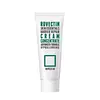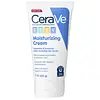What's inside
What's inside
 Key Ingredients
Key Ingredients

 Benefits
Benefits

 Concerns
Concerns

 Ingredients Side-by-side
Ingredients Side-by-side

Water
Skin ConditioningPropanediol
SolventCetyl Ethylhexanoate
EmollientButylene Glycol
HumectantHydrogenated Poly(C6-14 Olefin)
EmollientSqualane
EmollientTheobroma Cacao Seed Butter
EmollientCetearyl Alcohol
EmollientPolyglyceryl-3 Methylglucose Distearate
EmulsifyingCaprylic/Capric Triglyceride
MaskingNiacinamide
SmoothingPentylene Glycol
Skin ConditioningGlyceryl Stearate
EmollientHydrogenated Vegetable Oil
EmollientPrunus Persica Kernel Oil
EmollientCeramide NP
Skin ConditioningAstaxanthin
Skin ConditioningPanthenol
Skin ConditioningRubus Idaeus Seed Oil
EmollientRosa Damascena Flower Oil
MaskingOlea Europaea Fruit Oil
MaskingHaematococcus Pluvialis Extract
AntioxidantEclipta Prostrata Extract
Skin ConditioningMelia Azadirachta Flower Extract
Skin ConditioningPelargonium Graveolens Flower Oil
MaskingMelia Azadirachta Leaf Extract
Skin ConditioningCitrus Aurantium Dulcis Peel Oil
MaskingCurcuma Longa Root Extract
MaskingOcimum Sanctum Leaf Extract
Skin ConditioningEucalyptus Globulus Leaf Oil
PerfumingJuniperus Mexicana Oil
MaskingSalvia Sclarea Oil
MaskingCorallina Officinalis Extract
Skin ConditioningMoringa Oleifera Seed Oil
Emollient1,2-Hexanediol
Skin ConditioningDiisostearyl Malate
EmollientPolymethylsilsesquioxane
Synthetic Beeswax
Emulsion StabilisingCetearyl Olivate
Sorbitan Olivate
EmulsifyingHydroxyethyl Acrylate/Sodium Acryloyldimethyl Taurate Copolymer
Emulsion StabilisingHydroxyacetophenone
AntioxidantPalmitic Acid
EmollientStearic Acid
CleansingSodium Polyacryloyldimethyl Taurate
Emulsion StabilisingHydrogenated Polydecene
EmollientTromethamine
BufferingAdenosine
Skin ConditioningSorbitan Isostearate
EmulsifyingSodium Phytate
Trideceth-10
CleansingCarbomer
Emulsion StabilisingXanthan Gum
EmulsifyingHydrogenated Lecithin
EmulsifyingGlycerin
HumectantWater, Propanediol, Cetyl Ethylhexanoate, Butylene Glycol, Hydrogenated Poly(C6-14 Olefin), Squalane, Theobroma Cacao Seed Butter, Cetearyl Alcohol, Polyglyceryl-3 Methylglucose Distearate, Caprylic/Capric Triglyceride, Niacinamide, Pentylene Glycol, Glyceryl Stearate, Hydrogenated Vegetable Oil, Prunus Persica Kernel Oil, Ceramide NP, Astaxanthin, Panthenol, Rubus Idaeus Seed Oil, Rosa Damascena Flower Oil, Olea Europaea Fruit Oil, Haematococcus Pluvialis Extract, Eclipta Prostrata Extract, Melia Azadirachta Flower Extract, Pelargonium Graveolens Flower Oil, Melia Azadirachta Leaf Extract, Citrus Aurantium Dulcis Peel Oil, Curcuma Longa Root Extract, Ocimum Sanctum Leaf Extract, Eucalyptus Globulus Leaf Oil, Juniperus Mexicana Oil, Salvia Sclarea Oil, Corallina Officinalis Extract, Moringa Oleifera Seed Oil, 1,2-Hexanediol, Diisostearyl Malate, Polymethylsilsesquioxane, Synthetic Beeswax, Cetearyl Olivate, Sorbitan Olivate, Hydroxyethyl Acrylate/Sodium Acryloyldimethyl Taurate Copolymer, Hydroxyacetophenone, Palmitic Acid, Stearic Acid, Sodium Polyacryloyldimethyl Taurate, Hydrogenated Polydecene, Tromethamine, Adenosine, Sorbitan Isostearate, Sodium Phytate, Trideceth-10, Carbomer, Xanthan Gum, Hydrogenated Lecithin, Glycerin
Water
Skin ConditioningGlycerin
HumectantCetearyl Alcohol
EmollientCaprylic/Capric Triglyceride
MaskingCetyl Alcohol
EmollientCeteareth-20
CleansingDimethicone
EmollientPetrolatum
EmollientPotassium Phosphate
BufferingCeramide NP
Skin ConditioningCeramide AP
Skin ConditioningCeramide EOP
Skin ConditioningCarbomer
Emulsion StabilisingBehentrimonium Methosulfate
Sodium Lauroyl Lactylate
EmulsifyingSodium Hyaluronate
HumectantCholesterol
EmollientPhenoxyethanol
PreservativeDipotassium Phosphate
BufferingDisodium EDTA
Phytosphingosine
Skin ConditioningXanthan Gum
EmulsifyingEthylhexylglycerin
Skin ConditioningWater, Glycerin, Cetearyl Alcohol, Caprylic/Capric Triglyceride, Cetyl Alcohol, Ceteareth-20, Dimethicone, Petrolatum, Potassium Phosphate, Ceramide NP, Ceramide AP, Ceramide EOP, Carbomer, Behentrimonium Methosulfate, Sodium Lauroyl Lactylate, Sodium Hyaluronate, Cholesterol, Phenoxyethanol, Dipotassium Phosphate, Disodium EDTA, Phytosphingosine, Xanthan Gum, Ethylhexylglycerin
 Reviews
Reviews

Ingredients Explained
These ingredients are found in both products.
Ingredients higher up in an ingredient list are typically present in a larger amount.
This ingredient is an emollient, solvent, and texture enhancer. It is considered a skin-softener by helping the skin prevent moisture loss.
It helps thicken a product's formula and makes it easier to spread by dissolving clumping compounds.
Caprylic Triglyceride is made by combining glycerin with coconut oil, forming a clear liquid.
While there is an assumption Caprylic Triglyceride can clog pores due to it being derived from coconut oil, there is no research supporting this.
Learn more about Caprylic/Capric TriglycerideCarbomer is a polymer of acrylic acid. Its main role is to create a gel consistency.
A high amount of carbomer can cause pilling or balling up of products. Don't worry, most products contain 1% or less of carbomer.
Ceramide NP is a type of ceramide and formally known as ceramide 3.
Ceramides are intercellular lipids naturally found in our skin that bonds dead skin cells together to create a barrier. They are known for their ability to hold water and thus are a great ingredient for dry skin.
Ceramides are an important building block for our skin barrier. A stronger barrier helps the skin look more firm and hydrated. By bolstering the skin ceramides act as a barrier against irritating ingredients. This can help with inflammation as well.
If you would like to eat ceramides, sweet potatoes contain a small amount.
Read more about other common types of ceramides here:
Ceramide AP
Ceramide EOP
Cetearyl alcohol is a mixture of two fatty alcohols: cetyl alcohol and stearyl alcohol. It is mainly used as an emulsifier. Emulsifiers help prevent the separation of oils and products. Due to its composition, it can also be used to thicken a product or help create foam.
Cetearyl alcohol is an emollient. Emollients help soothe and hydrate the skin by trapping moisture.
Studies show Cetearyl alcohol is non-toxic and non-irritating. The FDA allows products labeled "alcohol-free" to have fatty alcohols.
This ingredient is usually derived from plant oils such as palm, vegetable, or coconut oils. There is debate on whether this ingredient will cause acne.
Due to the fatty acid base, this ingredient may not be Malassezia folliculitis safe.
Learn more about Cetearyl AlcoholGlycerin is already naturally found in your skin. It helps moisturize and protect your skin.
A study from 2016 found glycerin to be more effective as a humectant than AHAs and hyaluronic acid.
As a humectant, it helps the skin stay hydrated by pulling moisture to your skin. The low molecular weight of glycerin allows it to pull moisture into the deeper layers of your skin.
Hydrated skin improves your skin barrier; Your skin barrier helps protect against irritants and bacteria.
Glycerin has also been found to have antimicrobial and antiviral properties. Due to these properties, glycerin is often used in wound and burn treatments.
In cosmetics, glycerin is usually derived from plants such as soybean or palm. However, it can also be sourced from animals, such as tallow or animal fat.
This ingredient is organic, colorless, odorless, and non-toxic.
Glycerin is the name for this ingredient in American English. British English uses Glycerol/Glycerine.
Learn more about GlycerinWater. It's the most common cosmetic ingredient of all. You'll usually see it at the top of ingredient lists, meaning that it makes up the largest part of the product.
So why is it so popular? Water most often acts as a solvent - this means that it helps dissolve other ingredients into the formulation.
You'll also recognize water as that liquid we all need to stay alive. If you see this, drink a glass of water. Stay hydrated!
Learn more about WaterXanthan gum is used as a stabilizer and thickener within cosmetic products. It helps give products a sticky, thick feeling - preventing them from being too runny.
On the technical side of things, xanthan gum is a polysaccharide - a combination consisting of multiple sugar molecules bonded together.
Xanthan gum is a pretty common and great ingredient. It is a natural, non-toxic, non-irritating ingredient that is also commonly used in food products.
Learn more about Xanthan Gum